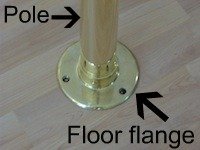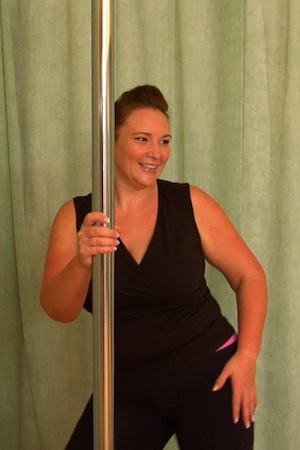- Home
- Pole Gear
- Dance Poles
- Permanent Dance Pole Info
- Permanent Dance Pole Safety
Permanent Dance Pole
Safety Info & Tips
Many people think that safety is not a concern with permanent dance poles. After all, they're screwed into both the floor and ceiling, so what could go wrong?
But while it's true that the permanently installed poles are generally safer than any other type of pole, there are still some safety issues that should be considered.
The reason that a permanent dance pole is so safe is that the tubing is fitted inside a flange at each end, both of which are then attached with 3 or 4 screws into the ceiling and the floor.
But to get the safety benefits of the permanent mounting system, it's critical to follow the manufacturer's installation instructions.

For example, the ceiling flange must be installed into a ceiling joist or support beam (sometimes also called a "stud" or a "2 by 4").
The floor must also offer a secure installation point for the floor flange, and the manufacturer's instructions will tell you exactly what you need to do to ensure this.
If you're unsure, call the customer support number that any reputable manufacturer or retailer will supply.
Permanent Dance Pole = Highest Weight Limit
Permanently affixed poles generally have the highest weight limit of all the different options. Because they are permanently attached to the floor and ceiling, they can usually handle more weight and more force than any of the other options.

For this reason, many plus size women who are concerned about weight limits prefer a permanent pole dancing pole.
In fact, anyone who wants to have the strongest possible setup will probably look at this type of pole as an option.
Be aware, however, that any structure is only as strong as its weakest part. Just because your equipment is bolted to floor and ceiling, doesn't mean it can't break or bend.
If the material used to construct the tubing is soft (brass is softer than stainless steel for example), your ceilings are very high, and/or the tubing material is thin, one or a combination of these factors can make for an unsafe setup, even though your pole may be bolted into place.
Safety - An Ounce of Prevention...
Even with high quality permanent dancing poles, it's important not to take safety for granted. You should check the floor and ceiling flanges (including the screws) regularly for any loosening or wear.
Also, check the set screws or rivets that secure the tubing to the flanges. These stop the pole from unintentionally rotating, which can be very dangerous if you're not expecting it!
Of course, just because a permanent mounting system is potentially more safe than your other options, doesn't mean those other options are unsafe!
In fact, if installed and used according to the manufacturer's instructions, all types of poles are relatively safe, as long as you play within the limits of your pole's specific design, and take your own fitness level into account.
Safety Recap - Permanent Dancing Poles
- Ensure correct installation by securely screwing the flanges into floor and ceiling joists.
- Check the floor and ceiling flanges regularly for any loosening or wear, and tighten screws if necessary. Replace damaged flanges or stripped screws right away.
- Ensure that the tubing length, diameter, thickness and construction material are of suitable quality to withstand the intended load.
- Check the set screws or rivets that secure the tubing to the flanges, and tighten if necessary to avoid unintentional rotation.
What's New?
-
Find Colorado Pole Dancing Classes
Oct 31, 25 02:44 PM
Searching for Colorado pole dancing opportunities? Come on in and let us help you find a class near you with our free directory. -
Plus Size Dance Pole Guide - Top Poles with Higher Weight Limits
Jul 31, 25 03:03 PM
What's the best plus size dance pole? Not all poles are created equal. Find out which brands support higher weight limits, and which ones to avoid. -
Pole Dance Studios in Brazil | Global Pole Directory
Jul 26, 25 04:55 PM
Explore pole dance studios and instructors across Brazil. Find pole fitness classes for all levels and styles with the Brazil pole dancing directory. -
Pole Fitness in Hawaii | Worldwide Pole Dance Directory
Jul 14, 25 11:39 PM
Searching for pole fitness in Hawaii? Look no further! Discover pole studios and instructors across Hawaii and start your pole dance fitness adventure today! . -
London Pole Studios & More | Pole Dancing in England
Jul 13, 25 11:44 PM
Discover top pole studios in London as well as pole dancing classes throughout England. Find local studios near you to start your pole dancing adventure today.
Your Pole Pal loves to have fun, but she also has to earn a living, right? That's why you'll see ads on this site. She may also earn commissions on some of the products you'll see here, but there's never any cost to you since the advertisers pay for these.
The income generated through these means helps ensure Your Pole Pal can devote the time to providing you with all the free and fabulous information & resources you'll find on this website.
Want to learn more? Your Pole Pal invites to you read her full advertising disclosure. You know...in case you haven't read enough legalese lately.




